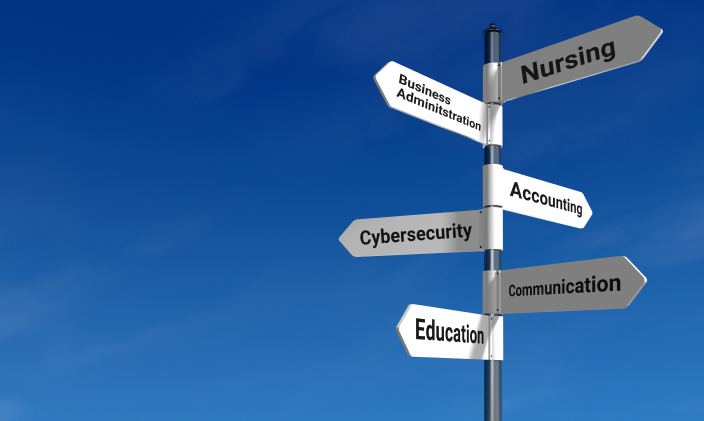How to use learning and development programs to create learning ecosystems

Written by Michael Feder

Reviewed by Kathryn Uhles, MIS, MSP, Dean, College of Business and IT

Everybody comes to work with a combination of life, educational and professional experience. That’s what makes employees unique assets for any business. But it also means employees have different skills and different skill gaps.
The educational background of employees can factor into their success at work. The U.S. Bureau of Labor Statistics reports that higher education can lead to higher wages, more opportunities and lower unemployment. Employees may arrive with anything from a GED certificate or high school diploma to a technical degree to a doctorate. Does that mean individuals with more education need less learning and development (L&D) programs than people with less education?
Not necessarily. But it does mean that L&D opportunities need to accommodate a diverse workforce. And those opportunities themselves are growing increasingly diverse.
Taking every employee into account
From all this, a challenge arises: How do companies implement helpful L&D programs while also considering their employees’ individual experiences?
The answer is complex. Individual concerns must be weighed against group cohesion, as well as a need for standardization and repeatability. An L&D program that focuses too much on the individual, for instance, might be as ineffective as one that is too general.
It's no wonder then that the traditional methods of L&D can result in a disconnect with employees. There’s nothing more boring than attending a seminar on something you learned in school four years ago or that could have been covered in a short video. This can cause an employee to mentally check out and even miss critical information.
The solution? L&D is taking a more holistic approach known as a learning ecosystem.
What is a learning ecosystem?
Before L&D formalized into the discipline that we know today, it generally took the form of on-the-job training. This training would be standardized, independent of an individual worker’s particular job experience.
While this traditional approach does a good job of boosting productivity, it takes a very nearsighted perspective on learning and development. Namely, it only includes learning that occurs in the workplace, related directly to the technical skills needed for successful production.
In contrast, a learning ecosystem describes learning that occurs both inside and outside of the workplace, including formal and informal means. In other words, a learning ecosystem includes all the social, cultural and technological learning sources that can affect an employee’s performance. This approach is a breath of fresh air for people entering industries that emphasize L&D and who are looking for a more personal training experience.
Included in an employee’s learning ecosystem is everything from company-hired educators to friends they interact with outside of work. Every learning source in this ecosystem has one thing in common: Each has the potential to affect the performance trajectory of an employee.
Why is the learning-ecosystem model important?
The learning-ecosystem model may seem a little abstract because it has so many informal learning sources. Many of these sources are outside the control of managers to affect. At the same time, understanding how these learning sources factor into the day-to-day lives of employees can help managers craft L&D programming that works better for employees.
Here’s an example of how a holistic learning-ecosystem model can benefit L&D programming. Say an employee is catching up with an old friend outside of work. Their friend tells them about an internal office conflict that arose from a miscommunication, which escalated further.
When managers create an open forum, this employee may be able to relay this story to someone in HR, pointing out why communication skills are important to workplace cohesion. This can help direct the efforts of future L&D programming toward the development of communication skills and conflict avoidance.
If L&D only included technical training and did not take other types of learning into account, there would be no avenue for this employee to translate their life experience into a formal L&D program. This is the strength of the holistic viewpoint provided by the learning-ecosystem model.
What are the main elements of a learning ecosystem?
Training and development content
This content would include formal L&D content, like manuals, video courses and exams. In the learning-ecosystem model, this would also include much of the content that employees receive through informal means. An example would be a helpful “cheat sheet” prepared by a manager to help an employee with challenges they are likely to experience in their job.
Workshops, videos and other pieces of content that employees receive outside of work would be included as well.
Interpersonal interaction
This includes everyone from hired educators in training courses to older employees sharing their experience, and even external friends and family. These are all important learning sources that can affect an employee’s performance and the performance of L&D efforts overall. Managers with positive relationships with their employees, for instance, have a better shot at making their employees excited about an upcoming seminar or training.
Helpful technologies
Gone are the days when L&D had to be hands-on and in-person. Nowadays, those responsible for L&D programming know that employees use technology in all aspects of life and that this can translate to more engaging and successful L&D. L&D professionals surveyed for a 2021 LinkedIn® report cited the development of digital fluency as a top priority in ongoing L&D efforts.
LinkedIn is a registered trademark of LinkedIn Corporation and its affiliates in the United States and/or other countries.
Things like mobile apps and video courses may be more accessible and engaging to a tech-savvy employee. Communication technology can help connect employees virtually and foster a more positive and interconnected office atmosphere.
When is a learning ecosystem helpful?
As stated before, an educational background might not prepare you for every aspect of your work. For instance, there are many social aspects of working with others in an office culture that aren’t covered in college.
In a very critical way, L&D can help put the technical skills that employees received from their education into the specific social context of the office. This requires a model of L&D that takes that social context into account. The learning-ecosystem model is very helpful in this regard, because it assigns great value to the social influences that employees bring to work.
Emphasizing this social element is important, according to the LinkedIn® report, because most of the surveyed organizations have been and will continue to shift resources away from instructor-led training to online learning.
This approach can also benefit many traditional L&D programs, like on-the-job training. Not everybody learns in the same way. Some employees may benefit from hands-on training with educators, while others benefit from watching a video on their own time. A learning-ecosystem model provides as many avenues as possible for employees to learn. This can give employees a sense of control and ownership over their learning.
Finally, the learning-ecosystem model can help build a healthier office culture. It provides ample opportunity for employees to speak about their life experiences, and incorporate them into their work life. Employees can feel heard and see their experiences translated into the office culture.
New trends in the learning-ecosystem model
Online learning platforms
Access to e-learning platforms offers managers a number of advantages when it comes to learning and development. Employees can access online training course and videos at any time. This allows employees to make decisions about when training works best with their schedule. At the same time, these platforms provide managers a transparent view of course completion across a company.
These platforms provide opportunity for helpful data collection and analysis to improve training over time.
Diversity and inclusion training
As opposed to traditional training, the learning-ecosystem model takes the social and cultural context of work into account. Diversity and inclusion training is an example of this philosophy in action. It provides an opportunity for employees to get to know each other better and understand each other’s personal backgrounds. This can help make everyone feel included and work better as a team.
According to the L&D industry report prepared by LinkedIn®, 64% of L&D professionals globally — and nearly three-quarters (73%) in North America — report that their executives have made diversity & inclusion (D&I) programs a priority.
Alliances with educational institutions
Another way businesses can offer effective education and training offerings is by joining forces with educational institutions — like University of Phoenix — to supplement their L&D opportunities. Through e-learning platforms, businesses can provide access to videos, lectures, courses and degree offerings on a wide variety of topics, often at no cost to the employee. This provides a great opportunity for employees to earn college credits while they work as part of these educational alliances, making it easier for them to pursue their education while working.
When it comes to the success of any business, fostering talent in the office can go a long way. Incorporating the holistic approach afforded by the learning-ecosystem model will continue to provide new insights and opportunities to achieve learning and development goals.

ABOUT THE AUTHOR
A graduate of Johns Hopkins University and its Writing Seminars program and winner of the Stephen A. Dixon Literary Prize, Michael Feder brings an eye for detail and a passion for research to every article he writes. His academic and professional background includes experience in marketing, content development, script writing and SEO. Today, he works as a multimedia specialist at University of Phoenix where he covers a variety of topics ranging from healthcare to IT.

ABOUT THE REVIEWER
Currently Dean of the College of Business and Information Technology, Kathryn Uhles has served University of Phoenix in a variety of roles since 2006. Prior to joining University of Phoenix, Kathryn taught fifth grade to underprivileged youth in Phoenix.
This article has been vetted by University of Phoenix's editorial advisory committee.
Read more about our editorial process.
Read more articles like this:


